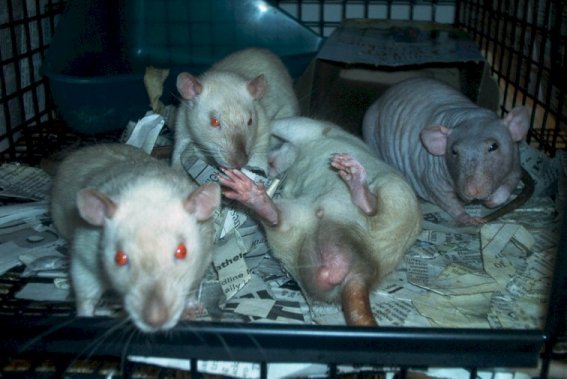Another Rat
I have to emphasize how important it is for your rat's mental health to have a rat companion. Unlike hamsters, rats are not solitary animals, far from it. They are not as territorial as gerbils. Male mice are especially prone to getting into bloody or deadly fights. Rats are not. You can usually introduce any rat or group of rats to any existing group and expect no more trouble than a few days of nonviolent wrestling, chasing, and determining the new social structure. (Much information here is seen on my other site in the article "A Lone Rat.") All information here applies to BOTH GENDERS unless otherwise stated. "He" or "she" pronouns can be interchanged. I have a rat who lives alone permanently because of his aggression and inability to accept new companions after his died. I also have rats that were alone temporarily due to quarantine, so most of this information is from my personal experience.
 Why Rats Need Company
Why Rats Need Company
Imagine a young man or lady who is moved away from her parents and siblings just after school age or so. She moves to an apartment or even a mansion with a pet of some sort. She can hug and talk to this pet, but they don't speak the same language. She has plenty to eat and lots of board games and music and other amusements. However, she has no telephone or internet or TV or any way of ever seeing or talking to another human being for the rest of her life. Can a person live like this? Maybe a few very rare ones fit the hermit lifestyle. Should a rat live like this?
Rats rely on each other for social needs like grooming and warmth and just a play companion their own age and species. If a rat feels a little under the weather or is injured, she may stop cleaning herself. Without a companion to help, she runs the risk of getting sick or infected. Rats that are kept alone heal more slowly and get sick more often than those living in a pair or group. In fact, many people recommend not to separate a rat after surgery.
A lonely rat can become neurotic and develop very bothersome habits. He may act bored or depressed most of the time, dig frantically at corners, chew cage bars incessantly, even start mutilating himself by chewing his nails too short, plucking out his own fur, or chewing on his tail.
Rats are most active in the late night and very early morning. No amount of toys is a replacement for the companionship of another rat. Rats sleep together, groom each other, play together and very much enjoy each other's company. It is as essential to their lives as having shelter and a healthy diet.
 Myths of the Lone Rat
Myths of the Lone Rat
People have a lot of reasons for deciding they want a single pet. I have heard most of them, and nearly all of them are not good enough for depriving a rat of probably the most important thing in its life.
"If I get two, they will bond with each other and ignore me." This is simply not true! Often this remark comes from people who have owned dwarf hamsters, mice, or gerbils (all social animals, like rats). However, unlike rats, these are animals that probably won't "bond" to you to begin with! They are not as dog-like in their bonding as rats are. The truth is, with rats, if you have one or ten, they will rush to be with you whenever you are near. A companion will likely help them become more comfortable with you and the surroundings much sooner, which only strengthens the bond. The only reason a single rat may seem to want to be with you more than two or more is that she is so bored and desperate for any kind of touch that she just begs for it.
"Two males will fight, so it's better to keep them single." Another commonly held (and too often appearing in print) misconception. While male mice tend to be quite territorial and will often fight brutally, male rats fight no more than females, provided they grow up together and/or are introduced young.
"I have time/money for only one." I'm afraid this one is counter to your belief. Rats need companionship all the time, even when they sleep. Do you have the time to be that companion? To hold your rat and carry her with you all day? What about midnight to 4 am when she is most active and needs to play? As for the money, two rats need fewer toys and less coddling. As idealistic as this may sound, they just need you and each other. As for the food and cleaning, the cage doesn't need to be any bigger for two rats, needs cleaned only as often as before, and one more rat may mean $5 or $10 more for food for the year.
"My parents won't let me have more than one." Go get them. Bring them to the computer. Show them this page and any other reliable rat resource.
"My lease/landlord allows me only one pet." Unless you can sneak another one in or talk to him/her about it, that can't be helped. Consider instead a pet that can be happy alone, such as a hamster or male mouse. Or ask to see if anyone has a rat that lives alone (some rats, particularly males, have trouble accepting a new companion when was has died or has an inborn aggression that makes him difficult to house with other rats).
 Introductions
Introductions
So you've decided to get another rat but when and how will you introduce them? The most common questions are: How old should a new companion be? How long should I wait to introduce them? Where should they be introduced and what precautions do I take? What is normal behavior and what is dangerous fighting? These are all good questions.
First of all, remember to quarantine any and all new rats for at least two or three weeks!
Male rats accept babies (under 8 weeks) more readily than adults to their group. Females are more amiable to older rats and still accept youngsters quite easily. Pairs of young rats are better than single ones because they can keep each other from getting scared and will be less likely to pester the adults. It is easiest to introduce young rats to other young rats because they will see each other as siblings, but it is also fine to introduce a young rat to an older one. The most difficult to do is introduce two adults (though it usually works out). If a rat has been alone her whole life and she is over a year old, she may not readily take to a companion. She may even be aggressive and prefer to remain alone. This may not always be the case, but be prepared to separate any new rats if the situation sours. Also, variety makes no difference. Rats of any color or type recognize and get along with other rats.
A good way to begin introductions is by putting the rats together in a neutral zone. A bathtub or small room works well. The rats will investigate each other and most likely will do no wrestling or shows of dominance there. Giving them a chance to meet and know each others' smell can help them feel less threatened when introduced "for real." Many rat people recommend thoroughly cleaning the cage and masking odors (both cage and all rats') with vanilla or vinegar. However, I have found that this ultimately can increase tensions and cause rats to be confused and fight more. A rat who is going to be aggressive will be no matter what is changed (my personal experience, anyway). Have a spray bottle full of water on hand in case any serious fights break out. It is not for discipline but rather cools rats off and forces them to pause and/or separate, so you can remove one without being bitten. (Painful/dangerous bites can result if you are bitter accidentally when breaking up a fight!)
What you can expect in an introduction is the resident rats to follow new ones around, sniffing them vigorously and pinning them down for cleaning. New rats will often scream or squeak, may jump and run away, or stand up on their hind legs in a boxing pose. Young rats, especially females, sometimes have the habit of following around older rats and pestering or mounting them, and when the older rat confronts them, the younger will scream and run away. (She will then resume bothering the other one after a few minutes.) Other shows of dominance include huffing and pushing their sides against the new rat with fur raised. The rule of thumb for separation is if the new rat is seriously oppressed (like if he frantically runs away and is chased down and bullied repeatedly) or at "first blood" or "first bite." Healthy dominance does not include biting or injury. Most common rat fight wounds are missing toes or nails, nicks in ears (though these can also happen accidentally), and injured tails. Even in serious fighting, rats are not set out to kill each other. These wounds in themselves are not fatal but do mean the rats aren't compatible. (Rats rarely hurt each other like that.) Make sure to keep any wounds clean while they heal. The most likely conflicts are between two adult rats with dominant personality. There cannot be two kings or queens and some rats feel they need to be "the boss." More passive adults can get along with bossy types, but only if they are also mellow. A nervous, jittery rat is more likely to get chased and bullied (it can work out if he is introduced with a mellow sibling or other friend).
It is best to bring home two rats to begin with! Siblings or parent-child bonds are very strong, and it is almost a guarantee that they will get along forever. Even a potentially aggressive rat will most likely not be a threat to his brother or to any rat he has grown up with since they were babies.


